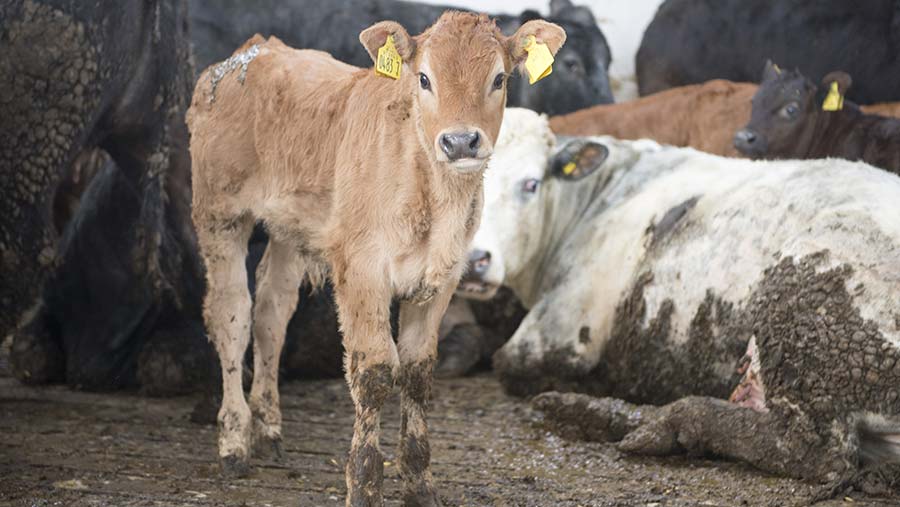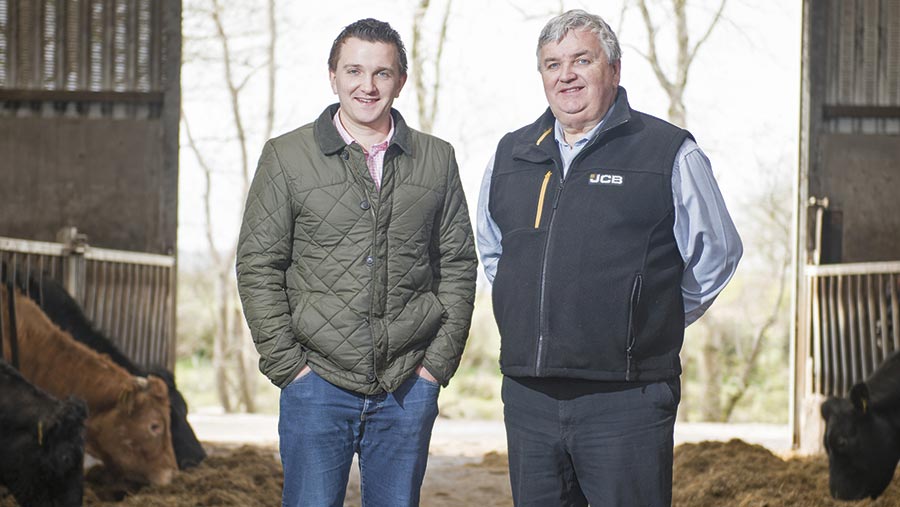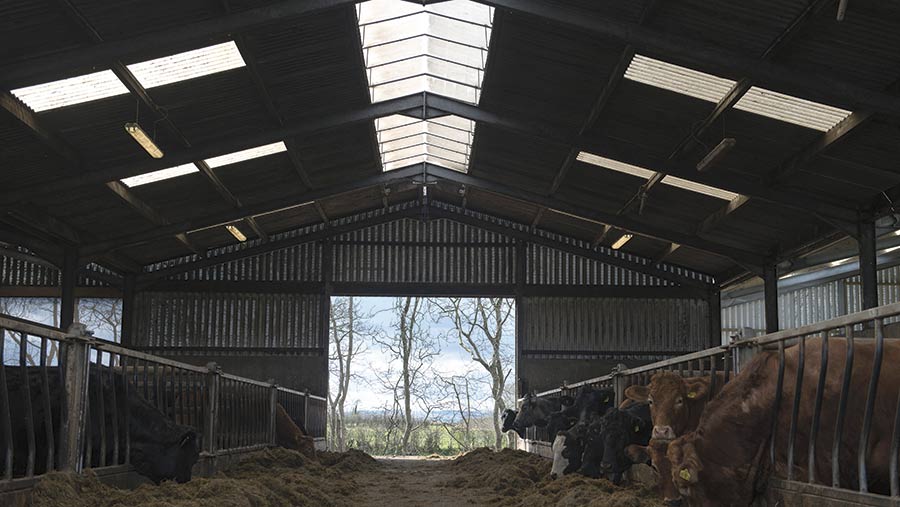Rethinking Cattle Performance: How suckled calf producers improved liveweight gains

The final workshop in Farmers Weekly’s Rethinking Cattle Performance series saw farmers visit the Anderson family’s suckler beef herd in Ballymoney, Northern Ireland, where they found out how they are achieving daily live weight gains above 1.2kg daily.
Northern Irish beef farmers Stewart and David Anderson are attaining daily liveweight gains of 1.2-1.7kg from their suckler calves by adopting strict breeding and health protocols.
Previously the father and son finished beef cattle and sold in-calf heifers at 30-months-old.
To improve herd efficiency they began calving at two in 2011. However, a lacklustre demand for smaller size heifers led them to establishing a suckler herd.
See also: How precision technology can fine-tune beef production
“You weren’t being rewarded for calving at two. Buyers wanted to buy three-year-olds because they were a stronger, bigger heifer.
“But I knew that in that extra six months I could have a calf on the ground and the cow back in calf again.”
David says initially he was nervous about calving at two but was pleasantly surprised with the results.
“They all calved themselves. In fact, I had more difficulty in the few that calved at 33 months. Overall, we have had very few calving difficulties from heifers calving at 22-24 months and no caesarians.
“It just shows it’s more to do with management.”

David (left) and Stewart Anderson. © BillyPix
They now have 80-suckler cows and heifers – predominately three-quarter Limousin – and sell nine-month-old store calves mainly through market.
Cow nutrition and subsequent condition plays a big role in aiding good calving, says David, who is a vet and has just finished working on a beef synchronisation project for Agrisearch.
For this reason, he condition scores cows and groups them at weaning.
“Thinner cows get grouped together and will be fed 0.5kg of barley for about two months to help them gain body condition.”
Breeding
Currently they calve in three batches – twice in the spring and once in the autumn.
For the past three years autumn calvers have been fix-time AI’d and if they fail to conceive they are turned in with the herd’s two Carnmorn Limousin stock bulls for four to six weeks.
Last year, cows were served to a Belgium Blue and heifers to a black Limousin with good maternal traits. Conception rates on heifers averaged 64% while conception rates on the cows were 75%.
Farm facts
- 5ha
- 65 suckler cows and 15 in-calf heifers
- ¾ Limousin and ¼ Simmental x BB
- Calving in three batches – Feb/March, April/May and August/September
However, David has also experimented with sexed semen on the heifers in this group.
In 2015, he AI’d the heifers to Simmental sexed semen (conception was 55%) to introduce some more milkiness into the herd and the cows were served to conventional Belgian Blue and Simmental (66% conception rates).
Typically, the spring calvers have always been bred to the Limousin stock bull for ease of management while at grass, but this year David will synchronise and AI them where possible.
“If a cow doesn’t get in calf she moves into the next calving batch. I’m trying to build up numbers so you can’t be too ruthless but at the same time I want to keep our blocks tight.”

‘Emphasis has been put on shed design to maximise ventilation, with light ridges installed in the roof to improve air flow’. © BillyPix
To help retain this tight calving and get more accurate calving dates animals served to AI are scanned five-weeks post service whereas those mated with the bull are pd’d seven weeks after the bull was introduced and again after one month.
Calf and cow nutrition
At calving all cows – except for the late spring calving group – are fed a 1kg blend and 1kg barley per head per day as well as good quality silage to make sure they hold condition for the next service while they are suckling their offspring.
A sheer grab is used to avoid spoilage at the pit face and reduce waste.
Depending on ground conditions cows are turned out to grass from April to September/October, although the autumn calvers are brought inside earlier in August and calve indoors.
Calves are creep fed a good quality 18% crude protein starter pellet from one month old and transition onto a lower 16% crude protein blend at three to four months prior to weaning at nine months.
“By six months they will be eating 4-5kg daily,” explains David.
Health and housing
They also run strict health and vaccination protocols at calving and have paid meticulous attention to housing to ensure optimum conditions for mixed stock.
A big emphasis has been placed on shed design to maximise ventilation, with light ridges installed in the roof to improve air flow.
Cows are kept on slats but pens have creep gates to provide calves with a straw-bedded area and access to feed.
They have also spent £500 installing cameras in the calving pens. David says it has been money well spent because it allows him to keep an eye on close-up cows and newly born calves to see if they’ve suckled their dams.
Marketing
Calves are sold at weaning at market. Although, for the past three years about 20% of calves have been sold direct to a finisher with a selection of males kept entire depending on the finisher’s requirements.
David said it works well because the finisher pays him market value and it saves on transport costs. Last year’s calves averaged £2.39/kg with heifers averaging 327kg and bullocks averaging 355kg.
Meanwhile, bulls made £2.20/kg and weighed 412kg.
Health protocols
- Calves are de-horned at tagging
- If cows don’t have adequate colostrum it is sourced from a nearby dairy farm that pasteurises its colostrum to kill bugs such as Johne’s and mycoplasma bovis
- Calves get vaccinated for pneumonia and IBR in the first three months
- They receive their second vaccinations at housing pre-sale
- Calves are drenched for vitamin E and selenium at birth
- They receive a coccidiosis drench at four weeks and this is repeated at eight weeks
- Heifers and cows are vaccinated once annually for BVD four weeks prior to service
- Worms: Calves and first and second lactation cows are treated for worms three weeks post turnout and thereafter every six weeks and then 3-5 weeks post housing
- Fluke: Late immature fluke is treated four-weeks post housing and mature three-months post housing.
Sponsors’ message
Thanks to ABP, Zoetis and Volac, whose sponsorship made it possible to run this Rethinking Cattle Performance workshop. Farmers Weekly had full editorial control of this article.
“ABP, Volac and Zoetis are committed to supporting UK cattle farmers in running enterprises that produce healthier, more productive animals.
Part of this commitment means working with organisations such as Farmers Weekly on initiatives such as the ‘Rethinking Cattle Performance’ campaign, to offer farmers the opportunity to learn from experts and their peers about the best ways to produce cattle, and particularly calves, as efficiently as possible.
